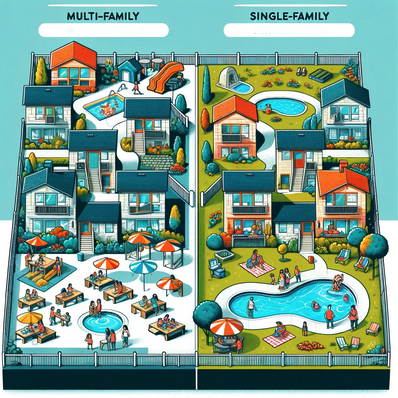Multi-Family vs Single-Family Rentals
Multi-Family vs Single-Family Rentals
Are you considering investing in rental properties but unsure whether to go for multi-family or single-family rentals?
We will explore the key differences between these two types of investments, including the number of units, property management, rental income potential, maintenance and repairs, tenant turnover, and financing options.
Discover the pros and cons of multi-family and single-family rentals to help you determine which type of rental property is right for you.
Let’s dive in!


What are Multi-Family and Single-Family Rentals?
Multi-family rentals refer to properties that have multiple housing units within a single building or complex, while single-family rentals pertain to individual standalone homes or townhouses that are rented out to tenants. Both multi-family and single-family rentals are popular choices in the real estate market for generating rental income and investment opportunities.
- Investors often find that multi-family rentals offer economies of scale, as they can generate rental income from several units within one property, spreading the risk of vacancy and increasing cash flow potential.
- On the other hand, single-family rentals provide a sense of autonomy and control, appealing to tenants looking for a more private living experience.
Understanding the nuances of each property type is crucial for investors to tailor their strategies and maximize returns in the competitive real estate landscape.
What are the Differences between Multi-Family and Single-Family Rentals?
The differences between multi-family and single-family rentals encompass various aspects such as the number of units, property management requirements, rental income potential, maintenance and repairs, tenant turnover rates, and financing options. Understanding these distinctions is crucial for investors and landlords to make informed decisions regarding their real estate investments.
Multi-family properties generally feature multiple units within a single complex, offering economies of scale in property management.
Single-family homes, on the other hand, require individualized attention for each property.
In terms of rental income, multi-family units often generate higher overall revenue due to the aggregation of rental income from multiple units.
Single-family rentals may appeal to tenants seeking more privacy and space.
Maintenance and repairs can be more streamlined in multi-family complexes but may require faster response times.
Tenant turnover tends to be higher in single-family properties, leading to potential vacancy risks, while financing options often vary in terms of eligibility criteria and interest rates between the two property types.
Number of Units
The number of units is a significant point of divergence between multi-family and single-family rentals. Multi-family properties consist of multiple units housed within a single building or complex, offering the potential for higher occupancy rates and overall rental income.
In contrast, single-family rentals consist of standalone properties with only one unit, limiting the potential income compared to multi-family units. With multi-family properties, economies of scale often come into play, allowing for more efficient management and maintenance, which can result in lower management requirements per unit.
On the other hand, single-family rentals may require more individual attention and oversight, increasing the workload for property owners or managers. The number of units can impact the overall risk exposure and diversification of a rental property portfolio, influencing investment strategies and potential returns.
Property Management
Effective property management is essential for both multi-family and single-family rentals to ensure tenant satisfaction, timely maintenance, and efficient operations. Multi-family properties often require professional management services due to the higher number of units and tenant interactions.
Managing multi-family properties involves handling a diverse range of tenant needs and preferences, necessitating a proactive approach to tenant relations and conflict resolution. Ensuring that maintenance requests are promptly addressed and that common areas are well-maintained is crucial in keeping tenants satisfied and reducing turnover rates.
In single-family rentals, a key focus is on efficiently screening potential tenants to find reliable individuals who will uphold the terms of the lease agreement, minimizing the risk of late payments or property damage.
Rental Income Potential
The rental income potential varies between multi-family and single-family rentals based on factors such as occupancy rates, rental rates, and market trends. Multi-family properties may offer higher profit margins and ROI due to economies of scale and diversified rental income streams.
On the other hand, single-family rentals can provide more stability in terms of occupancy rates and rental income, especially in certain market conditions. The demand for single-family homes is generally more resilient, offering a steady flow of rental income even during economic downturns. The rental rates for single-family properties may not always reach the high levels seen in some multi-family buildings. This difference can impact the overall investment returns and long-term profitability of single-family rental properties.
Maintenance and Repairs
Maintenance and repair responsibilities differ between multi-family and single-family rentals, with multi-family properties generally incurring higher maintenance costs due to shared amenities and common areas. Proper maintenance is crucial for preserving property value and tenant satisfaction.
Regular upkeep not only ensures the longevity of the property but also plays a significant role in attracting and retaining tenants. In a single-family rental, the maintenance burden falls directly on the owner, allowing for more control over the upkeep schedule and quality of work. On the other hand, multi-family rentals require a coordinated effort among property managers, maintenance staff, and tenants to address communal areas, such as parking lots, elevators, and recreational facilities.
Tenant Turnover
Tenant turnover rates can vary between multi-family and single-family rentals, impacting occupancy levels and rental demand. Understanding tenant preferences and market dynamics is essential for reducing turnover and maintaining stable rental income.
In multi-family properties, high turnover rates can lead to frequent vacancies, making it challenging to maintain high occupancy levels. This can result in increased pressure to attract new tenants quickly, potentially affecting rental demand.
On the other hand, single-family rentals may experience lower turnover rates, but longer vacancy periods between tenants can still impact overall occupancy rates. Property managers need to conduct thorough market analysis to stay competitive in attracting and retaining tenants in both rental housing markets.
Financing Options
Financing options for multi-family and single-family rentals play a crucial role in determining investment feasibility and ROI. Investors must consider factors such as loan terms, interest rates, and property valuation when choosing suitable financing for their real estate investments.
Considering the different financing structures available, investors need to assess whether a fixed-rate mortgage or an adjustable-rate mortgage aligns best with their investment strategy. Fixed-rate mortgages provide stability with consistent monthly payments, whereas adjustable-rate mortgages may offer lower initial rates but carry the risk of potential rate hikes in the future. Understanding the impact of these financing options on cash flow projections and long-term returns is essential for making informed decisions about property acquisition and maximizing investment potential.

What are the Pros and Cons of Multi-Family Rentals?
Multi-family rentals offer advantages such as diversified income streams, economies of scale in maintenance, and professional property management. Challenges like tenant turnover, complex financing, and increased management responsibilities can pose drawbacks for landlords.
On the positive side, by owning multi-family rentals, landlords can benefit from having multiple units under one roof, allowing for more efficient cost-sharing on major expenses like roof repairs or landscaping. Income diversification across various units can help offset the risks associated with vacancies or non-payment of rent by some tenants.
Managing multiple occupants and units also means increased tenant interactions, potential conflicts, and higher turnover rates compared to single-family properties. These factors necessitate strong organizational skills and swift problem-solving abilities on the part of the landlord.
Pros of Multi-Family Rentals
The advantages of multi-family rentals include higher profit potential due to multiple rental units, reduced vacancy risk through diversified income, and economies of scale in property management, leading to increased rental income.
Multi-family properties offer investors greater income stability compared to single-family homes, as they are less susceptible to fluctuations in market conditions. The ability to spread risk across multiple units within the same property provides a buffer against the impact of a single vacancy, ensuring a more consistent cash flow. Operational efficiencies such as shared utility costs, maintenance staff, and management resources contribute to cost savings and higher overall return on investment for property owners.
Cons of Multi-Family Rentals
The disadvantages of multi-family rentals can include higher maintenance costs for common areas, complexities in tenant management across multiple units, and potential challenges in securing financing for larger properties.
Managing maintenance in multi-family rentals can be more demanding compared to single-family properties. With multiple units sharing common spaces, wear and tear issues can arise frequently, leading to increased repair and upkeep expenses.
Tenant management complexities also stem from having to address the varied needs and preferences of occupants in different units, potentially resulting in more time-consuming interactions and conflicts to resolve.
Securing financing for larger multi-family properties can be more intricate due to stricter lending criteria and higher upfront costs involved in purchasing and maintaining such real estate assets.
What are the Pros and Cons of Single-Family Rentals?
Single-family rentals offer advantages such as lower maintenance costs, easier financing options, and greater privacyfor tenants. Challenges like limited rental income diversification and higher vacancy risks are considerations for landlords in the competitive rental market.
While single-family rentals can provide a stable income stream, the reliance on a single property can also pose risks in terms of geographical market fluctuations and tenant turnover.
Landlords may face challenges in diversifying their rental portfolios to mitigate these risks and adapt to changing market conditions. Managing multiple single-family properties dispersed across different locations can be logistically demanding for landlords, requiring active involvement in property upkeep and tenant management to ensure tenant satisfaction and retention.
Pros of Single-Family Rentals
The advantages of single-family rentals include potential property appreciation over time, greater privacy and control for tenants, and the opportunity for stable rental income from a single property.
Property appreciation is a key factor that attracts many investors to single-family rentals. As real estate values tend to increase in the long run, owners of single-family homes often benefit from substantial appreciation in their property’s worth.
Tenants prefer single-family rentals due to the privacy and autonomy they offer compared to multi-unit complexes. This preference results in higher tenant satisfaction and longer lease durations, contributing to a more stable rental income stream for property owners.
Cons of Single-Family Rentals
The drawbacks of single-family rentals can include higher tenant turnover rates due to individual lease agreements, limited income diversification from a single property, and fluctuations in rental demand based on location and market trends.
Tenant turnover in single-family rentals poses a significant challenge for property owners as it can lead to frequent vacancies and associated costs such as advertising for new tenants and potential property maintenance between tenancies.
The lack of income diversification from a single property increases risk in case of unexpected expenses or prolonged vacancies, highlighting the importance of building a diversified real estate portfolio.
Understanding market demand considerations is crucial to predicting rental income potential and identifying areas with stable demand to ensure consistent cash flow.
Which Type of Rental Property is Right for You?
Choosing between multi-family and single-family rentals requires evaluating your investment goals, property preferences, location considerations, and amenities offered. Understanding your risk tolerance and financial resources is essential in determining the right rental property type for your investment portfolio.
If you aim for higher cash flow and diversification, multi-family units might align better with a long-term investment strategy. These properties can provide multiple rental income streams within a single investment.
Conversely, single-family homes offer greater potential for appreciation and simpler management due to fewer tenants. Location plays a crucial role in rental property success, so assessing neighborhood demographics, proximity to amenities, and rental demand are key factors to consider.
Conducting a thorough risk assessment helps in gauging potential challenges and rewards associated with each property type.
Consider Your Goals and Resources
When deciding on the type of rental property, consider your investment goals, financial resources, and market trends in the housing sector. Assessing your risk appetite and financing options will help align your investment strategy with your long-term objectives.
Understanding the current market dynamics is crucial in determining the potential return on investment (ROI) when selecting a rental property. By staying abreast of housing market trends and forecasting future developments, investors can make informed decisions that optimize their financial resources.
It’s also essential to evaluate the financing considerations associated with different types of rental properties to ensure that the chosen investment aligns with your budget and funding options. Conducting thorough due diligence on the property’s location, amenities, and potential for rental income can further enhance the chances of achieving your investment goals.
Evaluate the Local Market
Assessing the local market dynamics, including rental vacancy rates, demand-supply balance, and rental trends, is essential in determining the feasibility of investing in multi-family or single-family rentals. Analyzing market data will help you make informed decisions regarding property acquisitions.
By closely monitoring rental demand and vacancy rates, you can gauge the competitiveness of the rental property market in a given area. Understanding these factors allows for a comprehensive evaluation of potential rental income and overall market stability.
Keeping an eye on rental trends and analyzing historical data provides valuable insights into future rental property performance. This strategic analysis is crucial in identifying lucrative investment opportunities and minimizing risks associated with fluctuations in the real estate market.
Determine Your Risk Tolerance
Evaluating your risk tolerance is crucial when choosing between multi-family and single-family rentals. Consider the level of involvement required in property management, tenant interactions, and financial commitments to align your risk tolerance with the rental property type that best suits your investment strategy.
Property management responsibilities play a significant role in determining the level of risk associated with real estate investments. Landlord responsibilities range from maintenance and repairs to handling tenant concerns and ensuring property compliance. Understanding these obligations helps in assessing the potential risks involved in property management.
Tenant relations also impact risk assessment as positive relationships can lead to stable income streams while conflicts may result in financial losses and property damage. Financial risks, including market fluctuations and unexpected expenses, must be carefully evaluated to make informed investment decisions.
Frequently Asked Questions
What is the difference between multi-family and single-family rentals?
Multi-family rentals refer to properties that have multiple units, such as apartment buildings or townhouses, while single-family rentals are properties that have only one unit, such as detached homes or condos.
Which type of rental property is more profitable, multi-family or single-family?
This depends on various factors such as location, rental demand, and maintenance costs. Generally, multi-family rentals have a higher potential for profit due to multiple units generating income, but single-family rentals can also be profitable in the right market.
What are the benefits of investing in multi-family rentals?
Investing in multi-family rentals allows for diversification of income, lower vacancy rates, and potentially higher cash flow compared to single-family rentals. It also allows for economies of scale in terms of maintenance and management costs.
Are there any advantages to owning single-family rentals?
Single-family rentals provide more privacy and control for the owner, as they do not have to share the property with other tenants. They also tend to have longer tenancy periods and higher appreciation potential.
What are the risks of investing in multi-family rentals?
Multi-family rentals may have higher upfront costs and require more complex management. They are also more prone to economic fluctuations and require a larger down payment.
Is it better to start with single-family or multi-family rentals for first-time investors?
This depends on the investor’s goals and resources. Single-family rentals may be a better option for beginners as they typically require less upfront costs and are easier to manage. However, multi-family rentals can also be a viable option with proper research and planning.